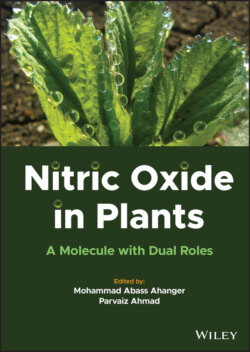Читать книгу Nitric Oxide in Plants - Группа авторов - Страница 25
2.3 NO Signaling and Gene Regulation Under Abiotic Stress
ОглавлениеIn animals, NO is involved in the regulation and the expression of different genes related to several different pathways, either directly by interacting with receptors involved in the signal transduction pathway, or indirectly by moderating the activity of transcription factors, or influencing the stability and translation of messenger RNA (mRNA) (Kolbert et al. 2021). Recently, a protein named “AtNOS1” exhibiting NOS activity has been recognized. This protein belongs to the NOS family (a novel family) and displays some similarity to previously reported mammalian NOS. It consists of a guanosine-5′-triphosphate (GTP)-binding domain and may have GTPase activity (Li et al. 2020). AtNOS1 activity is highly dependent upon Ca2+-calmodulin/NADPH−; however, it is independent of FAD, FMN, and BH4. Studies have provided a genetic basis for a role of AtNOS1 as a source of NO in abscisic acid (ABA)-induced closure of stomata, in the suppression of flowering, and the defense responses induced by lipopolysaccharides (Wang et al. 2020). Under abiotic stress, ABA production is the key stress response in plants. The signaling between ABA and NO governs the major molecular mechanisms that incorporate external signals to modify internal systems leading to plant adaptations against stress (Falak et al. 2021). NO interacts with ABA to modulate the gene expression and the protein function. For example, ABA prevents water loss through stomatal closure and contributes to the synthesis of osmolytes. It has been observed that in the guard cells of Arabidopsis thaliana, ABA increases H2O2 production, which in turn regulates the production of NO, which subsequently regulates the stomatal closure (Li et al. 2020; Wang et al. 2020; Falak et al. 2021).
Salicylic acid (SA) is another organic plant compound that contributes to the modulation of seed germination, vegetative defense, and response to changing environment. The association between NO and the non-expressors of pathogenesis-related proteins, i.e. NPR1, NPR3, and NPR4 (SA receptor genes), is well recognized for plant defense (Prakash et al. 2021). These NPR proteins regulate various transcription factors (TFs) and endure posttranslational changes (modulated by SA). S-nitrosylation of NPR proteins modifies NO signaling through oligomerization of NPR (Falak et al. 2021; Prakash et al. 2021). NO also controls the expression of NPR1 during plant defense. In Arabidopsis, the SA-dependent defense response has been shown to be triggered by NO. For instance, the application of the NO donor “GSNO” (S-nitrosoglutathione) enhanced the expression of NPR1 and its analogous protein, which subsequently improved the SA content and induced PR genes, conferring resistance against Pseudomonas. Moreover, a rapid change in the levels of glutathione, which is important for the activation of NPR1 and accumulation of SA, has been induced by NO (Fatima et al. 2021; Hediji et al. 2021; Kaur et al. 2021).
